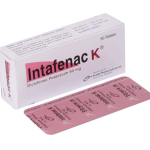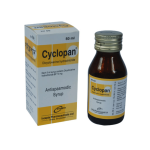DicloGel(Diclofenac Sodium)

Therapeutic Group: Nonsteroidal Anti-Inflammatory
Presentation
DicloGelTMGel: Each gram gel contains Diclofenac Diethylamine BP equivalent to Diclofenac Sodium 10 mg.
Description
Diclofenac is a potent nonsteroidal anti-inflammatory drug (NSAID) with clinically proven anti-inflammatory, analgesic and antipyretic properties. NSAIDs, including diclofenac, reduce pain principally by inhibiting formation of prostaglandins, leukotrienes and free oxygen radicals. All non-salicylate NSAIDs reversibly block cyclooxygenase activity, which is responsible for converting arachidonic acid to prostaglandins. Diclofenac is a potent, non-selective inhibitor of COX-1 and COX-2 (preferentially COX-2), which may underlie both its therapeutic efficacy and potential side effects. In addition, diclofenac, when compared to NSAIDs such as ibuprofen, also blocks the lipoxygenase pathway of the arachidonic acid cascade, thereby inhibiting the formation of leukotriene B4 (LTB4), which is a known pain mediator and has been shown to stimulate pain receptors in the peripheral nerves. The inhibition of lipoxygenase also prevents the proinflammatory and gastrointestinal damaging effects of leukotrienes. The lipoxygenase inhibition produced by diclofenac may therefore play a significant role in its efficacy as an analgesic and anti-inflammatory agent. Menthol is a vasodiator. It dilates the blood vessels, produces a feeling of coolness and produces analgesia. Methyl salicylate is a known anti-inflammatory agent.
Indications
Relief of pain associated with recent (acute), localized muscle or joint injuries such as sprains, strains or sports injuries ( e.g. ankle sprain, shoulder strain or back muscle pain). This is typically as an adjunct to other measures, such as rest, for the relief of discomfort associated with such injuries.
Dosage & Administration
For external use only.
Adults and adolescents aged 16 years and over:
It should be applied over the affected area 3 or 4 times daily. It should be rubbed gently into the skin. The amount needed depends on the size of the painful area: 2 g to 4 g (1 g equals a strip approx. 2 cm long) of gel is sufficient to treat an area of about 400-800 cm². The duration of treatment depends on the natural course of healing, rest and also on clinical response.
Geriatrics (> 65 years of age):
The usual adult dosage may be used.
Paediatrics (< 16 years of age):
Not for use in children under 16 years of age.
Side Effects
Usually well tolerated. Extremely low frequency of hypersensitivity reactions.
Precautions
This gel is for topical use only and should be applied only to intact, non-diseased skin and not to skin wounds or open injuries. It should not be allowed to come into contact with the eyes or mucous membranes, and should never be taken by mouth. Discontinue the treatment if a skin rash develops after applying the product.
Use in Pregnancy & Lactation
Pregnancy:
It is not recommended for use in pregnancy and contraindicated during the last trimester of pregnancy.
Lactation:
It is not recommended for use in lactation.
Drug Interaction
No interactions with other drugs are to be expected.
Over Dose
The low systemic absorption of topical diclofenac renders overdose very unlikely. Treatment should be restricted to symptomatic and supportive measures.
Storage
Do not store above 30 C. Keep away from light and out of the reach of children.
Commercial Pack
DiclogelTM Gel: Each tube contains 50 gm gel.



